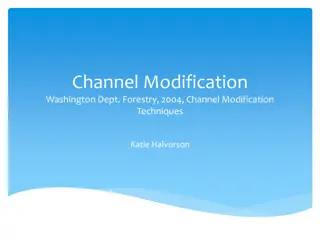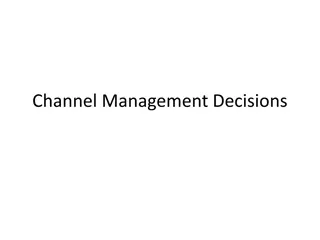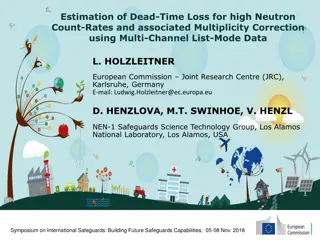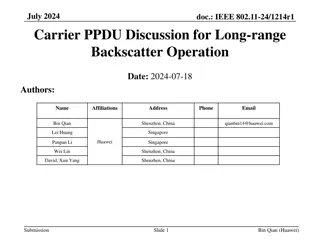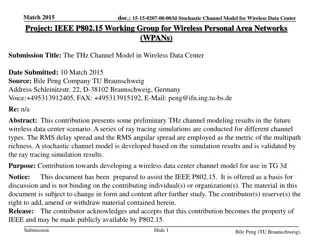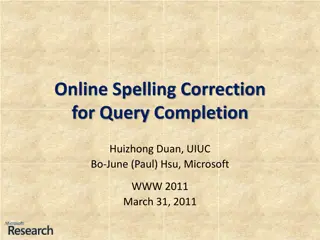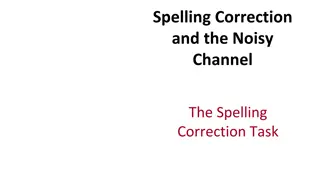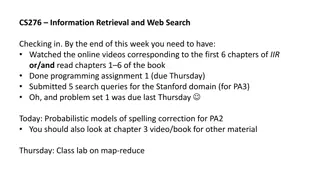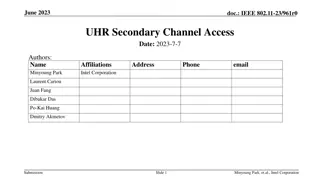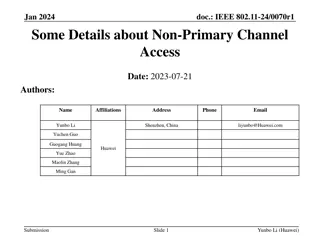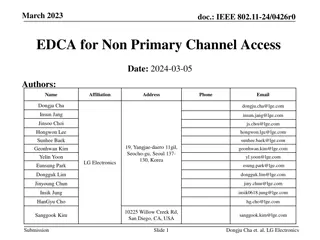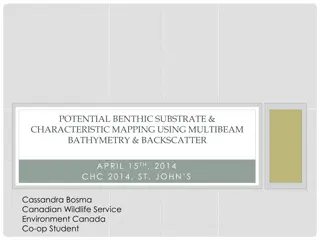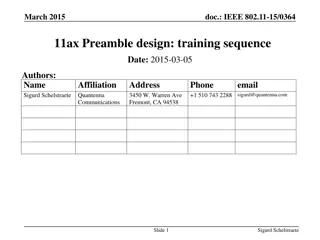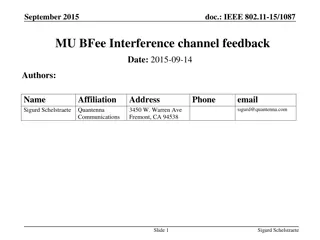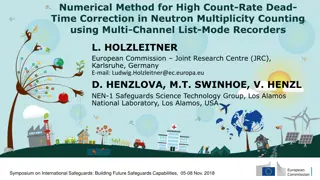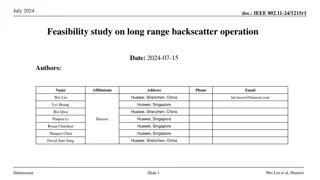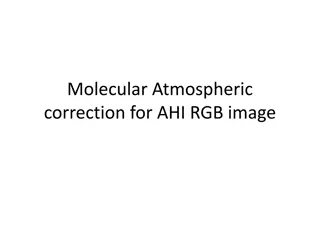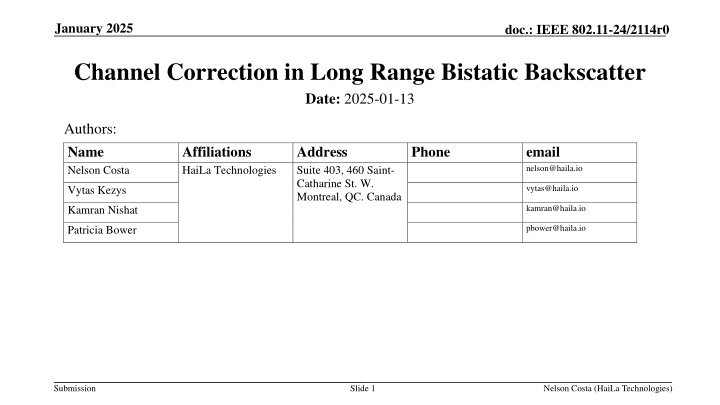
Channel Correction in Long Range Bistatic Backscatter
Explore the concept of channel correction in long-range bistatic backscatter communication within the IEEE 802.11 standard, addressing compensation for both radio and channel impairments. The submission discusses the utilization of training sequences, impulse responses, and proposed excitation waveforms to optimize signal transmission and reception efficiency.
Download Presentation

Please find below an Image/Link to download the presentation.
The content on the website is provided AS IS for your information and personal use only. It may not be sold, licensed, or shared on other websites without obtaining consent from the author. If you encounter any issues during the download, it is possible that the publisher has removed the file from their server.
You are allowed to download the files provided on this website for personal or commercial use, subject to the condition that they are used lawfully. All files are the property of their respective owners.
The content on the website is provided AS IS for your information and personal use only. It may not be sold, licensed, or shared on other websites without obtaining consent from the author.
E N D
Presentation Transcript
January 2025 doc.: IEEE 802.11-24/2114r0 Channel Correction in Long Range Bistatic Backscatter Date: 2025-01-13 Authors: Name Nelson Costa Affiliations HaiLa Technologies Address Suite 403, 460 Saint- Catharine St. W. Montreal, QC. Canada Phone email nelson@haila.io vytas@haila.io Vytas Kezys kamran@haila.io Kamran Nishat pbower@haila.io Patricia Bower Submission Slide 1 Nelson Costa (HaiLa Technologies)
January 2025 doc.: IEEE 802.11-24/2114r0 Abstract This contribution introduces the concept of channel correction in long range bistatic backscatter. We also review training sequences already defined in 802.11, and how they can be reused in a long range bistatic backscatter use case. Submission Slide 2 Nelson Costa (HaiLa Technologies)
January 2025 doc.: IEEE 802.11-24/2114r0 Long Range Bistatic Backscatter In addition to compensating from radio impairments, we need to compensate for channel impairments. In a bistatic topology, there are threephysical channels, or paths represented by the impulse responses h0, h1, h2. Ideally, an impulse response describes a path s transfer function across all frequencies. This is important because the Txer transmits energy outside of its center frequency, and the Rxer listens to energy outside of its center frequency. Submission Slide 3 Nelson Costa (HaiLa Technologies)
January 2025 doc.: IEEE 802.11-24/2114r0 Long Range Bistatic Backscatter h0 h1 h2 The path from transmitter to receiver. This carries the AMP DL PPDU, centered at channel 1. This represents the interfering self-jamming signal. The path from the transmitter to AMP STA. This also carries the AMP DL PPDU, centered at channel 1. The path from the AMP STA to receiver. In the case of channel shifting, the signal carried here is centered on a different frequency from the transmitter. (e.g. channel 11) Submission Slide 4 Nelson Costa (HaiLa Technologies)
January 2025 doc.: IEEE 802.11-24/2114r0 Long Range Bistatic Backscatter The only surviving portion in h2 is the modified Excitation field. The only way to train the receiver on the AMP STA s uplink signal is using training symbols within this excitation field. The Rxer hears a concatenation of signals from all three physical channels. Excitation signal through h1 The resulting signal through the uplink h2 Rxed signal txed signal through h0 Modulated to a different channel by the AMP STA Submission Slide 5 Nelson Costa (HaiLa Technologies)
January 2025 doc.: IEEE 802.11-24/2114r0 Proposed Excitation Waveform As discussed in [2], there are benefits to using the 802.11b/g 1 or 2 Mb DSSS waveform. Submission Slide 6 Nelson Costa (HaiLa Technologies)
January 2025 doc.: IEEE 802.11-24/2114r0 Existing Training Sequences for Channel and Radio Impairments There are already many well-defined training schemes defined for 802.11 PHYs. It is important to note that, without penalty to the AMP STA, the transmitter can encode any training sequence in the Excitation field. The AMP STA only has to flip bits to encode new data. Most of the complexity and power consumption for a given PPDU format is consumed at the transmitter, not the AMP STA. Reusing existing training sequences has several advantages Existing 802.11 receivers will recognize the backscattered PPDU format. (Receiver diversity, market acceptance) Existing training sequences are already proven useful in mitigating radio and channel impairments. Submission Slide 7 Nelson Costa (HaiLa Technologies)
January 2025 doc.: IEEE 802.11-24/2114r0 Preambles and Training Sequences: Comparison Amendment 11a (Clause 17) Preamble Modulation OFDM BWs (MHz) 5, 10, 20 Training STF, LTF Preamble Durations 24 s Notes 11 (Clause 15) DSSS 22 Barker 144 s No STF, LTF. Training comes from repeated Barker sequence. Each occurrence of the Barker sequence can be combined (averaged) to get a better estimate of channel and radio impairments. The Barker sequences enable very simple estimation techniques. 11b (Clause 16) DSSS 22 Barker 144 s, 72 s (2 Mb and above) DSSS 22 Barker 11g (Clause 18) Depending on BW, T_SHORT = 8, 16, 32 s T_LONG = 8, 16, 32 s HT_MF: HT mixed format OFDM 20 11n OFDM 20, 40 L-STF, L-LTF T_SHORT and T_LONG VHT and HT include more training after the legacy fields (L-STF, L-LTF, L-SIG) that involve a variable length field (VHT-LTF) or variable number of fields (HT-LTFs). 11ac OFDM 20, 40, 80, 160 11ah 11ax OFDM OFDM 1, 2, 4, 8, 16 20, 40, 80, 160 20 (WUR Basic) 40, 80 (WUR FDMA) 20, 40 , 80, 160, 320 STF, LTF1 L-STF, L-LTF Each Tx mode has its own PPDU format, but same preamble. 8 + 8 = 16 s 11ba OOK L-STF, L-LTF 11be OFDM L-STF, L-LTF Submission Slide 8 Nelson Costa (HaiLa Technologies)
January 2025 doc.: IEEE 802.11-24/2114r0 802.11b Versus Other Training Sequences 11b DSSS PHYs have different preamble format than HT or Legacy preambles. DSSS PHYs rely on the Barker sequence for detection, recovery and channel estimation. Using 11b preambles keeps backward compatibility with a wide variety of already deployed WLAN networks. Submission Slide 9 Nelson Costa (HaiLa Technologies)
January 2025 doc.: IEEE 802.11-24/2114r0 Estimation Accuracy: 11b Preamble Versus HT (L-LTF) Consider the case where we d like to compare the estimation accuracy of the 11b preamble (Barker sequence-based training) to an HT or Legacy preamble. Submission Slide 10 Nelson Costa (HaiLa Technologies)
January 2025 doc.: IEEE 802.11-24/2114r0 Estimation Accuracy: 11b Preamble Versus HT (L-LTF) The Barker sequence channel estimate is always more accurate than using the L- LTF. This is largely because the channel estimate can be averaged over the longer 11b preamble. The estimation error is roughly 10 dB less for 11b versus HT. How this translates to actual performance benefits in real implementations is yet to be determined. Submission Slide 11 Nelson Costa (HaiLa Technologies)
January 2025 doc.: IEEE 802.11-24/2114r0 Conclusions To help enable long range backscatter, we need training sequences embedded in the backscattered waveform. As for any PPDU, the receiver uses these training sequences to correct for channel and radio impairments. Depending on implementation, estimation accuracy can improve link margins. Largely due to the preamble length, 11b waveforms can enable much more accurate channel estimation. In backscatter operations, the AMP STA does not have to create the training sequences! The transmitter (AMP Supporting STA) can embed training in the Excitation field. Submission Slide 12 Nelson Costa (HaiLa Technologies)
November 2024 doc.: IEEE 802.11-24/2114r0 Straw Polls SP1: Do you agree that, in order to enable long range bistatic backscatter, there must be training symbols in the excitation field? Submission Slide 13 Nelson Costa (HaiLa Technologies)
November 2024 doc.: IEEE 802.11-24/2114r0 References [1] Qi et al., Further Discussion on AMP PPDU Design, 11-24/1780, November 2024. [2] Kezys et al, Low Complexity Backscatter AMP STA, 11- 24/2002, December 2024. [3] Costa et al., Follow-up on Channel Shifting in Backscatter Operations, 11- 24/2128, January 2025. Submission Slide 14 Nelson Costa (HaiLa Technologies)




